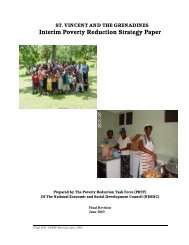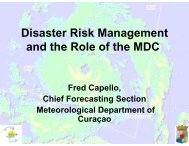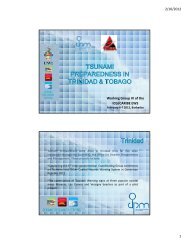The Anatomy of A Silent Crisis The Anatomy of A Silent Crisis
The Anatomy of A Silent Crisis The Anatomy of A Silent Crisis
The Anatomy of A Silent Crisis The Anatomy of A Silent Crisis
- TAGS
- anatomy
- www.bb.undp.org
Create successful ePaper yourself
Turn your PDF publications into a flip-book with our unique Google optimized e-Paper software.
34 Forum 2009: Climate Change – <strong>The</strong> <strong>Anatomy</strong> <strong>of</strong> a <strong>Silent</strong> <strong>Crisis</strong><br />
Poverty: Climate change increases poverty<br />
Climate change and the cycle <strong>of</strong> poverty<br />
Because the poor tend to live in geographical and climatic regions that are naturally most<br />
vulnerable to climate change, their capacity to adapt is easily overwhelmed by the impact <strong>of</strong> the<br />
changing conditions. <strong>The</strong>y have the least assets to rely on in the event <strong>of</strong> a shock — whether it be<br />
a weather-related disaster, a bad harvest or a family member falling ill. <strong>The</strong>se factors build on each<br />
other and create a perpetuating cycle <strong>of</strong> poverty that is difficult to break. Safety net structures like<br />
insurance are also largely unavailable to the world’s poor. Many are subsistence farmers, fishermen,<br />
or have jobs in the tourism industry—vocations highly dependent on natural resources such as<br />
the ocean, forests and land for their livelihoods. Climate change compounds existing poverty by<br />
destroying livelihoods. Specifically, rising temperatures, changing rainfall patterns, floods, droughts<br />
and other weather-related disasters destroy crops and weaken or kill livestock. Rising temperatures<br />
and acidic oceans destroy coral reefs and accelerate the loss <strong>of</strong> fish stock. 99 Loss <strong>of</strong> biodiversity,<br />
weather-related disasters such as hurricanes, disease outbreaks and sea level rise have strong<br />
negative impacts on tourism. <strong>The</strong> Coral Reef Alliance estimates that coral bleaching can result in<br />
billions <strong>of</strong> dollars in losses due reduced biodiversity, coastal protection and income from reef fisheries<br />
and tourism. 100 $6-7 million losses are projected in the next 10 years if coral does not recover in the<br />
Philippines based on the net present value <strong>of</strong> the local diving industry. 111<br />
Climate change drives poverty through a vicious circle <strong>of</strong> reduced crop yield and resulting lower<br />
income, which leaves fewer resources for the following year’s planting season. About 60 percent<br />
<strong>of</strong> developing nations’ workforce, about 1.5 billion people, are employed in agriculture, livestock,<br />
fisheries and tourism. 102 Most <strong>of</strong> the farmers live on bare minimum production and losing a small<br />
amount <strong>of</strong> their yield pushes them even further into poverty. Fishermen and those employed in<br />
tourism lose income or become unemployed.<br />
<strong>The</strong> loss <strong>of</strong> biodiversity is worrisome not only due to its direct impacts on people’s livelihoods,<br />
but also due to the intrinsic value <strong>of</strong> biodiversity and its pivotal role in building the poor’s resilience<br />
to climate change. A vicious cycle evolves as climate change fundamentally alters ecosystems and<br />
reduces species diversity. For example, species diversity assists in strengthening the ability for cod<br />
or lobster fishing resources to sustain stress and shocks. Ecosystem self regulating processes<br />
are pivotal, such as the creation <strong>of</strong> natural carbon sinks which remove carbon dioxide from the<br />
atmosphere. Increased landscape diversity with varied plant species and natural coastline barriers<br />
like mangrove forests can protect coastal inhabitants and their belongings from climate shocks like<br />
coastal storms and soil erosion. Having an assortment <strong>of</strong> traditional seeds to help identify more<br />
drought resistant crop varieties is increasingly critical to survival in drought-prone areas. <strong>The</strong>re is<br />
great cause for concern as the IPCC estimates that 20-30 percent <strong>of</strong> global species are likely to be<br />
at risk <strong>of</strong> extinction this century.







